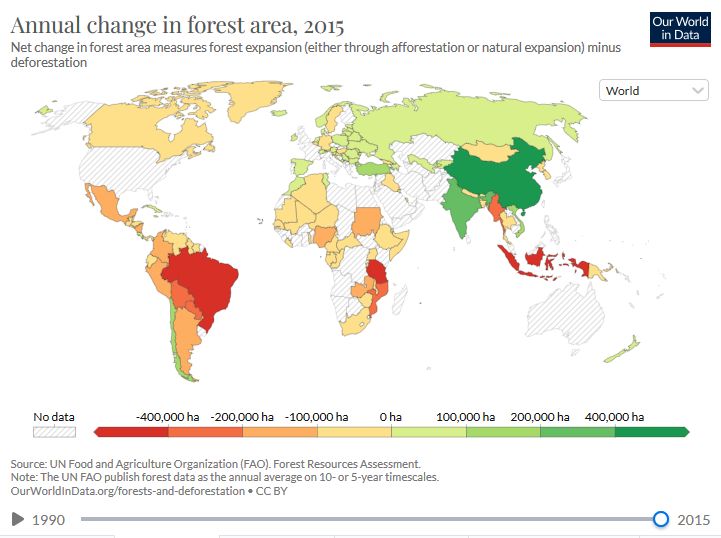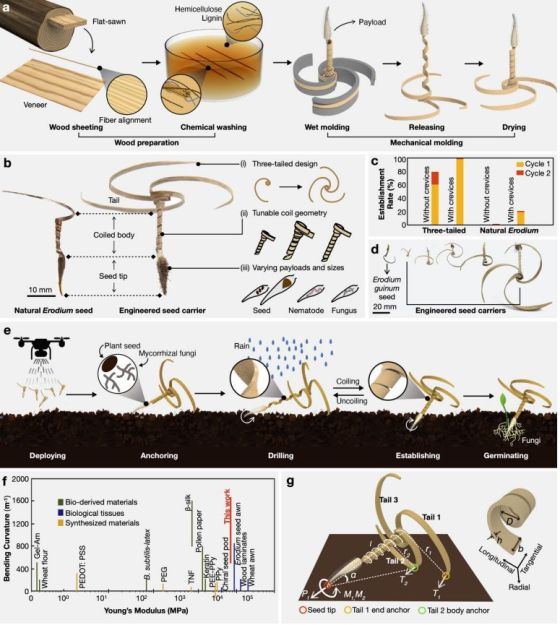
At first glance the problem of how to plant trees would seem to be a straightforward one: take a seed, jam it into the soil and let nature take its course. Or alternatively do much the same with a sapling that already got a start in a nice, comfortable greenhouse before leaving it to its own devices. To the average person this is generally the point where it’s considered a ‘done deal’, but one only has to take a look at the average survival rate of saplings out in the wild to perish that thought.
Each environment offers its own set of challenges when it comes to reforestation, which can perhaps be considered ironic as many of these trees are being planted where forests used to be, albeit centuries ago in many cases. There are the easy spots, such as flat fields, with rich soil, ample rain and mild weather, to the challenging terrain of Iceland, or mountainous terrain. Here the logistics are challenging and where once rich forests flourished, the very landscape seems adamant to reject this botanic intrusion.
Further complicating matters here are the myriad of reasons why we’re looking at planting so many new trees that it has even become an internet thing, as with the 2019 ‘Team Trees’ 20 million new trees challenge. So how did we get here, why exactly are we doing all of this, and how much of these attempts do bear fruit?
Where Forests Used To Roam
A good introduction to what forests used to look like thousands and even hundreds of years ago comes courtesy of the fine folk at Our World in Data and their Forest Area article.

Most of the deforestation took place over just the past few hundred years, as the human populations grew — to around 603 million by 1700 — along with the appetite for wood to be used for everything from building houses and ships to cooking dinner. This deforestation did not affect each region equally, with especially regions like Europe losing most of the forests that used to blanket it during the Middle Ages when the region hurtled towards new levels of economic expansion and accompanying need for resources such as wood.
As noted by Hannah Ritchie and Max Roser in the earlier linked article on deforestation, regions tend to follow a forest transition, with four distinct periods. With the first three being the gradually, then rapidly increasing deforestation before tapering off again. Finally, the fourth phase is the post-transition one, in which much of the forest cover of the first, pre-transition phase has been lost, but is gradually recovering.
Although Europe is now firmly in the post-transition phase, with forest cover slowly recovering from the very low level it was at last century, other regions are still going through the earlier phases due the strong drivers behind deforestation, and are experiencing the reasons why deforestation comes with a lot of negatives that the gain of more land for grazing and crops cannot compensate for. These mostly involve the loss of topsoil, mudslides as previously forested hillsides lose the root systems, loss of biodiversity and the loss of moisture in the soil due to the lack of shade.
Afforestation
The practice of reforestation — grouped under the term afforestation along with forest expansion — is as alluded to earlier a rather spotty practice, with different parts of the world showing wildly differing rates of forest cover increase, or even the continued (rapid) loss.
The reason why China looks to do remarkably well with reforestation is due to its national reforestation program, also called the Great Green Wall, that tries to turn the edges of the Gobi desert back into habitable land. This project was started in 1978, when it sought to increase China’s forest cover from 5 to 15%, and to over 24% by 2025 from 18% in 2009. So far these efforts have managed to not only halt the expansion of the Gobi desert — which used to grow around 10,000 square kilometers per year in the 1980s — but even revert it, with the Gobi desert shrinking by over 2,000 square kilometers per year.
Although there are concerns over the effect of these trees on the groundwater levels, and the negative effects of planting mostly the same tree species in an area, it is still an example of the positive effects that reforestation on a large scale can bring, along with a population that volunteers each year again to help plant more trees. What is definitely required to accomplish all of this is the will to change things, and funding to go with it. Something which is tricky when you’re not backed by a wealthy nation’s government.
Regardless, Team Trees showed in 2019 that it’s possible to get twenty million US dollar in donation money for the promise to plant twenty million trees, though this was not necessarily a reforestation campaign as it focused mostly on how much carbon these trees could remove from the atmosphere in the public messaging. Even so, they cooperated with the Arbor Day Foundation who seem to have indeed planted all those trees along with a description of the how and why.
What is perhaps most interesting about the summary of all these tree planting locations is how distinct they are, ranging from US forests ravaged by wildfires to the African version of the Great Green Wall that holds back the Sahara desert, as well as mangroves in Madagascar. This underlines the unique nature of each area, along with the types of trees that are most suited for it and the intended ecosystem. Even when not every tree planted will grow to maturity, a net increase in healthy forests is always welcome to see.
Making It Stick
During the whole Team Trees saga in 2019, it was clear that many of the YouTubers who joined in on the ‘crazy ways to plant trees’ spree weren’t doing it necessarily to actually plant trees, but mostly to make a cool video, get some street cred and perhaps even have a few of the saplings live through the experience. Most of the serious reforestation efforts are multi-year efforts by organizations such as Mossy Earth, whose attempt to restore the forests that once covered Iceland is a prime example of an environment that is everything but easy to work with.
It’s estimated that less than 1% of Iceland’s original forest still remain, resulting in today’s well-known volcanic ash-covered landscape, and a few herds of lonely sheep who love to dig into any unfortunate birch tree saplings that they happen to come across. This is the situation that has led to the ash storms that plague Iceland, eroding the soil and making life increasingly tougher for the human population and other critters alike.
By planting downy birch (Betula pubescens), rowan (Sorbus aucuparia), aspen (Populus tremula) and tea-leaved willow (Salix phylicifolia) trees, it is hoped that this trend will be reversed, along with an increase in the biodiversity. Even so, the soil that the team has to work with is very challenging, with the freeze/thaw cycle seemingly conspiring to destroy all of the hard work, as covered in this video by the team:
What is positive is that this is another project that is supported and at least partially financed by the state. This mirrors similar reforestation efforts by e.g. Canada’s ‘2 Billion Trees’ commitment, which seeks to plant the right species of trees in the right locations over a decade, to both help to capture carbon and restore biodiversity that was lost through forest clearing and other causes.
Yet it is also important to keep in mind that in nature, trees produce a lot of seeds. The reason for this is that most of those seeds will never grow into saplings, let alone mature trees. Many will fall prey to predation as birds and mammals will happily squirrel away these tasty, nutrient-packed snacks. Others will fail to sprout, get waterlogged or dry out and die, even if some critter will not snack on its tasty, tender leaves and stem. This makes it important to know when to plant a tree, and makes it attractive to plant larger saplings as these are more likely to survive.
Yet what if the area you want to reforest is very inaccessible? Here aerial seeding is a common approach, allowing for large areas to be covered in seeds. Yet germination rates with this method are low, which is why evolution has come up with a way to improve the chances with larger, more precious seeds, such as those from Erodium gruinum. The seeds from this particular plant are very long, with a tail at the top that when exposed to changes in moisture causes it to change shape. Over time and with some luck, this will work the seed into the soil where it can safely germinate.
This particular approach led to Danli Luo and colleagues to create a seed carrier design based on it (preprint PDF), only with three tails to improve the chances of successful drilling:

Although significantly more involved than merely taking some seeds and tossing them out of an airplane, this particular design could be highly beneficial in some cases. For example, it would be well suited to the whitebark pine, with its 11 mm long seeds and remote habitat. This particular tree is under threat from white pine blister rust, a fungal disease that’s wreaking havoc, with a small percentage showing genetic resistance to the fungus. Having this effective deployment method could make the efforts to protect this tree species from extinction a little bit easier.
No Easy Path
Even as some nations have already gone through their deforestation transition and onto reforestation, many other nations are still well in the second phase, while often also dealing with demand from other nations for products like beef, palm oil, etc., which often drives further deforestation. Here a major change may soon come in the form of further adoption of more productive and less water-hungry genetically engineered soy, corn, wheat and other crops by major importers such as China, which imports massive quantities of for example soybeans from South America.
As long as the drivers for deforestation aren’t addressed, the process will continue, but there is also a lot of hope in that net forest cover loss is gradually decreasing, with temperate regions actually gaining more forest since 1990, marking the beginning of a long recovery process. Although we could of course mod trees to grow a lot faster, the fact remains that growing a forest is a long process, and one that takes giving every seed and every sapling the best possible shot at becoming a part of said forest.
0 Commentaires